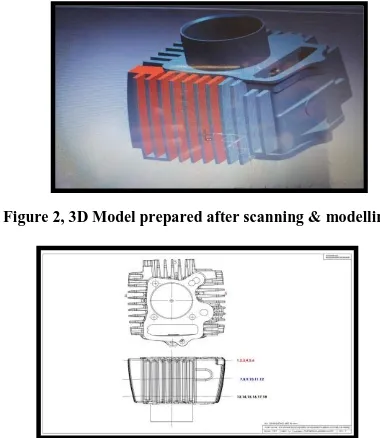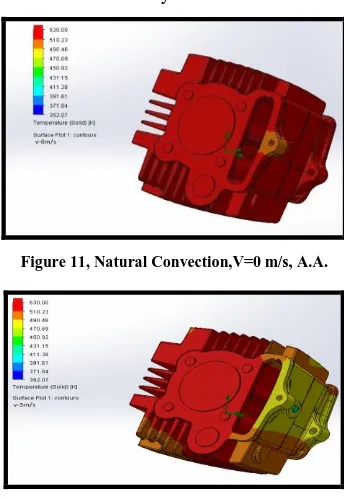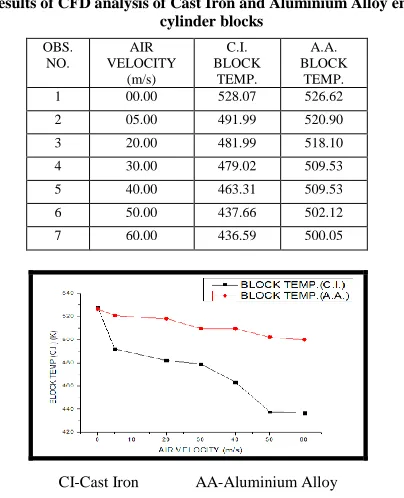International Journal of Emerging Technology and Advanced Engineering
Website: www.ijetae.com (ISSN 2250-2459, ISO 9001:2008 Certified Journal, Volume 8, Issue 1, January 2018)
341
Evaluation of the Thermal Performance of Aluminium Alloy
Cylinder Block for A Single Cylinder, Four Stroke, Air-Cooled
Spark Ignition Engine for Motor Cycle Application by using
CFD Technique
Appasaheb D. Patil
1, Dr. Ravindra G. Tikotkar
21Ass. Professor, Department of Mechanical Engineering, DKTES’s Textile & Engineering Institute, Ichalkaranji-416115,
Dist.Kolhapur, Maharashtra, India.
2Professor, Department of Mechanical Engineering, B.L.D.E.A’s V.P. Dr. P.G. Halakatti College of Engineering & Technology,
Vijayapur-586103, Dist.Vijaypur, Karnataka, India
Abstract-In Internal Combustion Engines the excessive
amount of heat is produced during the working. Due to this excessive heating, there is possibility of some adverse effects on the parts which are in contact of this heat. So, it is essential to remove this excessive heat from the overheated parts. For this purpose, an effective cooling system is introduced. The cooling effect can be achieved by using either air or water depending upon the type of cooling system used.
As the present work is concerned about the natural and forced/combined cooling, the temperature distribution in the Aluminium Engine cylinder blocks is evaluated with the help of CFD techniques and later compared with Cast Iron as a conventional material.
Keywords-3D scanning, air cooled spark ignition engine,
Aluminium Alloy engine cylinder block, CFD technique, Thermal performance.
I. INTRODUCTION
Focusing the attention on the air-cooled engines, in those cases the heat produced by the combustion is wasted toward the ambient surrounding the engine by a series of fins distributed over the external cylinder surface and licked by the air stream flowing externally to the cylinder itself. Generally, the fins are not symmetrically distributed respecting to the cylinder. This design strategy is necessary to try to compensate the non-uniform distribution of the air flow around the cylinder surface.
In the present paper, the air-cooling system performance of two engine cylinder block was done by using 3D CFD simulation techniques were evaluated by adopting a 3D-CFD simulation methodology suitable to predict the most critical aspects limiting the engine cooling efficiency. First results obtained by the proposed simulation methodology were presented in.
Federico Brusiania, Stefania Falfaria, et.al in their paper entitled “Definition of a CFD Methodology to Evaluate the Cylinder Temperature Distribution in Two-Stroke Air Cooled Engines”, a 3D-CFD simulation methodology is designed to perform a detailed evaluation of two stroke air-cooled engines. The methodology was applied on two different engines equipping handheld brush-cutter machines. The optimization of the air-cooling system of such a machine was a very challenging task because the machine design must be very compact forcing all the engine parts to remain quite close each other.[1]
A numerical investigation has been carried for a finned metal cylinder using CFD and is validated against the experiments carried out by Mishra A.K., Nawal S. and Thundil Karuppa Raj R. A transient numerical analysis is carried out with wall cylinder temperature of 423 K initially and the heat release from the cylinder is analyzed for zero wind velocity. The heat release from the cylinder which is calculated numerically is validated with the experimental results. They has been carried a numerical investigation for a finned metal cylinder using CFD and is validated against the experiments. An effort is made by them to study the effect of fin parameters on fin array performance which includes variation in pitch and fin material. In addition, this paper considers the effect of air flow velocity on different fin pitch by using CFD technique.[2]
International Journal of Emerging Technology and Advanced Engineering
Website: www.ijetae.com (ISSN 2250-2459, ISO 9001:2008 Certified Journal, Volume 8, Issue 1, January 2018)
342
A methodology is developed for the analysis of diesel engine in-cylinder processes and combustion by C.S. Sharma, T.N.C. Anand and R.V. Ravikrishna. For this, an algorithm is first developed to map a generalised three-dimensional Computational Fluid Dynamics (CFD) solution from an unstructured mesh in AVL FIRE to a structured mesh in KIVA-3V to provide initial conditions for the closed-valve simulations.[4]B.N. Niroop Kumar Gowd and Ramatulasi have been analyzed the thermal properties by varying geometry, material and thickness of cylinder fins. Parametric models of cylinder with fins have been developed to predict the transient thermal behavior. The models are created by varying the geometry, rectangular, circular and curved fins.[5]
Prof. Arvind S.Sorathiya1, Ashishkumar N. Parmar, Prof. (Dr.) Pravin P. Rathod have studied various researches done in past to improve heat transfer rate of cooling fins by changing cylinder block fin geometry, climate condition and material.[6]
CFD analysis was used by Hardik S Rajput¹ Vivek B Patel² to simulate the heat transfer of the engine block Maximized The Heat Transfer Rate By Changing The Fin Geometry by using CFD as a tool.[7]
P.T. Nitnaware, Prachi S. Giri, Optimized the design of an air cooled Internal Combustion Engine Fin Using CFD. This study is an attempt to understand the effects of the number of fins, fin pitch, relative wind velocity and ambient temperature on air-cooling of a two- wheeler IC engine using commercially available CFD codes.[8]
Amit Ranjan & D.S. Das has studied the heat transfer analysis of motorcycle engine cylinder using CFD under various fin geometries and speed condition.[9]
[image:2.612.345.535.483.702.2]II. CFDANALYSIS OF THE ENGINE CYLINDER BLOCK
Figure 1, Photography of Faro Make 3D Scanner
Before CFD analysis of the engine cylinder block, as it was necessary to prepare the model, the first step in this was 3D scanning.
The above photograph shows the FARO make 3D scanner. This scanner is used in the scanning of the block due to its complex shape on outside surface. As the fins of different size and shape are used, it was not possible to prepare on the modelling software, so the block was 3D scanned by using the scanner shown in the above photograph.
This is a forensic scan arm 3D scanner which is portable and non contact type. Its characteristics are like compact, light weight, simple to use, highly accurate, repeatable, high resolution data, non contact 3D scanning and measurement, rapid scanning speed, portable & maneuverable, no target or spray required, simple user interface and hard probing capabilities. It finds application in forensic anthropology, crime labs, medical examination, facial reconstruction, digital archiving of evidence and 3D printing replications of evidence. This offers benefits to the designer like reduced measurement time, generate automatic reporting, increased productivity and efficiency, meets quality standards and deliver products more quickly. After scanning, the model was prepared which was ready to analyze by using CFD techniques. Unigraphics is the software used for this with version NX7.
To get the results of CFD analysis of the model of the engine cylinder block, it was transported to SOLIDWORKS 2015 for further analysis. It was opened and by considering the variables like natural & forced convection, material of the blocks, wind velocity, heat transfer coefficients, etc. it was processed/analyzed. The results were obtained and given below.
[image:2.612.366.531.485.587.2]
Figure 2, 3D Model prepared after scanning & modelling
[image:2.612.58.278.528.674.2]International Journal of Emerging Technology and Advanced Engineering
Website: www.ijetae.com (ISSN 2250-2459, ISO 9001:2008 Certified Journal, Volume 8, Issue 1, January 2018)
343
III. RESULTS OF CFDANALYSIS OF CAST IRON &ALUMINIUM ALLOY ENGINE CYLINDER BLOCK
The block after modeling was analyzed by using CFD technique on computer. The results are given below. The variables like natural & forced convection, material of the blocks, wind velocity, heat transfer coefficients, material properties, etc. were considered for the analysis.
Results of CFD for Cast Iron engine cylinder block:
(V=0 to 60 m/s, Base temperature = 530 K)
Figure 4, Natural Convection,V=0 m/s,C.I.
[image:3.612.53.540.96.660.2]Figure 5, Forced Convection,V=5 m/s, C.I.
[image:3.612.348.535.101.643.2]Figure 6, Forced Convection,V=20 m/s,C.I.
Figure 7,Forced Convection,V=30 m/s,C.I.
Figure 8,Forced Convection,V=40 m/s,C.I.
Figure 9, Forced Convection,V=50 m/s,C.I.
[image:3.612.52.261.217.648.2]International Journal of Emerging Technology and Advanced Engineering
Website: www.ijetae.com (ISSN 2250-2459, ISO 9001:2008 Certified Journal, Volume 8, Issue 1, January 2018)
344
Initially, the natural convection condition was considered for the Cast Iron engine cylinder block. So, the velocity is assumed equal to 0 m/s. The temperature of the block is considered as 530 K on the inner surface. There is equal distribution of heat from inner surface of cylinder to the outer surface of fins and block as far as the results of CFD are concerned. Temperature on the outer surface is almost the same as compared to the inner surface in natural convection. But as air velocity increases, the temperature of the fins goes on decreasing as it can be seen from above figures.Results of CFD analysis of Aluminium Alloy engine cylinder block :
(V=0 to 60 m/s, Base temperature = 530 K)
[image:4.612.352.534.100.641.2]The Aluminium Alloy engine cylinder block after modeling was analyzed by using CFD technique on computer. The results are given below. The variables like natural & forced convection, material of the blocks, wind velocity, heat transfer coefficients, material properties, etc. were considered for the analysis.
Figure 11, Natural Convection,V=0 m/s, A.A.
Figure 12, Forced Convection,V=5 m/s, A.A.
Figure 13, Forced Convection,V=20 m/s, A.A.
Figure 14, Forced Convection,V=30 m/s, A.A.
Figure 15, Forced Convection,V=40 m/s, A.A.
[image:4.612.81.253.378.628.2]International Journal of Emerging Technology and Advanced Engineering
Website: www.ijetae.com (ISSN 2250-2459, ISO 9001:2008 Certified Journal, Volume 8, Issue 1, January 2018)
[image:5.612.76.253.122.245.2]345
Figure 17, Forced Convection,V=60 m/s, A.A.From the above study, the overall conclusion can be drawn as due to the high thermal resistance of the Cast Iron, the temperatures on the surface of the block are very low as heat is not dissipated properly. But for Aluminium Alloy, as thermal conductivity is high, temperatures on surface of the block are also high. So, there is better heat dissipation.
IV. THE RESULTS AND DISCUSSION
On the basis of CFD experimentation, various temperatures of the engine with natural and forced convection were recorded. The results are presented in tabular form.(Refer Table 1)
The results of the CFD analysis from Table I are presented in graphical form from view point of the changes in temperatures due to the type of convection based on velocities at which motor cycle/engine is operated.
Table I
Results of CFD analysis of Cast Iron and Aluminium Alloy engine cylinder blocks
CI-Cast Iron AA-Aluminium Alloy
Figure 18, Results of CFD analysis of Cast Iron and Aluminium Alloy engine cylinder blocks
From graph, it is clear that there is no much difference in temperature of CI cylinder block as there is higher thermal resistance in comparison of Aluminium Alloy as the material of block.
V. CONCLUSION OF CFDANALYSIS
1. As the CFD analysis was done by considering the factors like type of convection i.e. natural convection where the fluid velocity was zero and in forced convection fluid velocities were varied from 5 m/s to 60 m/s based on the survey of vehicle speed and air velocity, it is clear from the results that as the velocity increases, the temperature of the blocks goes on decreasing considerably so cooling is better in forced convection.
2. Again the material of the blocks is changed, the temperatures achieved are higher at the outer tip of the Aluminium alloy engine cylinder block in comparison with Cast Iron engine cylinder block due to higher value of thermal conductivity of Aluminium alloy. So, it can be said that heat dissipation is better with less weight.
3. From the CFD analysis, it can be said that as the Aluminium Alloy has higher thermal conductivity than Cast Iron, so better heat transmission and dissipation too. So, Aluminium Alloy (LM25TF) is recommended to use as engine cylinder material for motor cycle engines.
REFERENCES
[1] Federico Brusiania, Stefania Falfaria, Claudio Fortea, Giulio Cazzolia, “Definition of a CFD Methodology to Evaluate the Cylinder Temperature Distribution in Two-Stroke Air Cooled Engines”, ELSEVIER Energy Procedia 81, 765 – 774, 2015. [2] Mishra A.K., Nawal S. and Thundil Karuppa Raj R., “Heat
Transfer Augmentation of Air Cooled Internal Combustion Engine Using Fins through Numerical Techniques”, Research Journal of Engineering Sciences, ISSN 2278 – 9472, Vol. 1(2), 32-40, August (2012).
[3] Pulkit Agarwal, Mayur Shrikhande and P. Srinivasan, “Heat Transfer Simulation by CFD from Fins of an Air Cooled Motorcycle Engine under Varying Climatic Conditions”, Proceedings of the World Congress on Engineering 2011 Vol III WCE 2011, July 6 - 8, 2011, London, U.K.
[4] C.S. Sharma, T.N.C. Anand and R.V. Ravikrishna, “A methodology for analysis of diesel engine in-cylinder flow and combustion”, Progress in computational Fluid Dynamics, Vol x, No. x,200x, Inderscience Enterprises Ltd.
[image:5.612.69.271.456.705.2]International Journal of Emerging Technology and Advanced Engineering
Website: www.ijetae.com (ISSN 2250-2459, ISO 9001:2008 Certified Journal, Volume 8, Issue 1, January 2018)
346
[6] Prof. Arvind S.Sorathiya, Ashishkumar N. Parmar, Prof. (Dr.)Pravin P. Rathod, “Review Paper on Effect of Cylinder Block Fin Geometry on Heat Transfer Rate of Air-Cooled 4S SI Engine”, International Journal of Recent Development in Engineering and Technology, ISSN 2347 - 6435 (Online), Volume 2, Issue 1, January 2014, 33-38.
[7] Hardik S Rajput, Vivek B Patel,”Maximizing The Heat Transfer Rate By Changing The Fin Geometry Using CFD As A Tool”, IJSRD - International Journal for Scientific Research & Development| Vol. 2, Issue 03, 2014 | ISSN (online): 2321-061, 554-556.
[8] P.T. Nitnaware, Prachi S. Giri, “Design Optimization Of An Air Cooled Internal Combustion Engine Fin Using CFD”, Journal of Multidisciplinary Engineering Science and Technology (JMEST) ISSN: 3159-0040 Vol. 2 Issue 11, November – 2015, 3129-3131.



